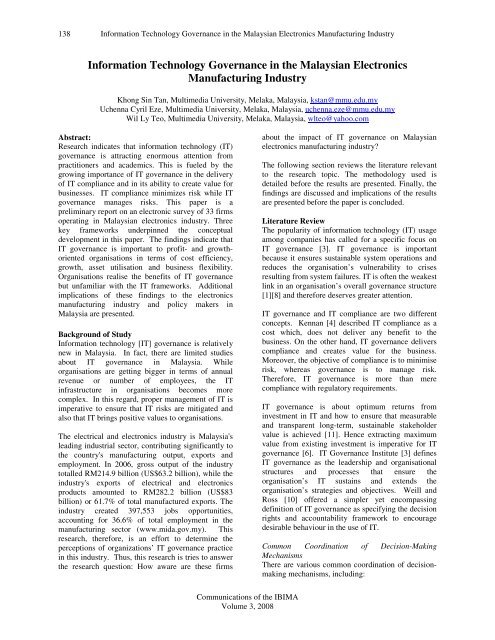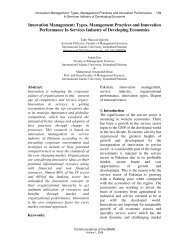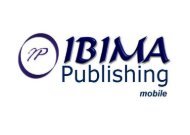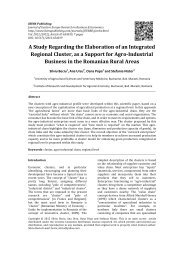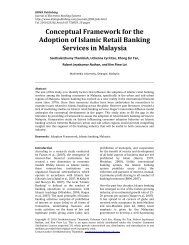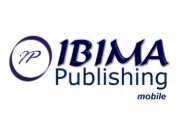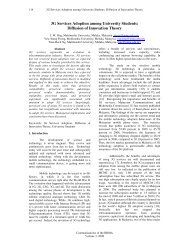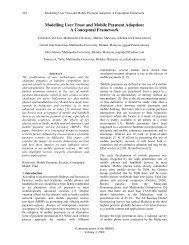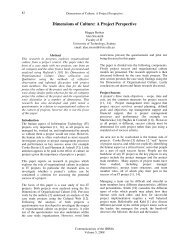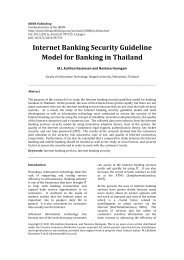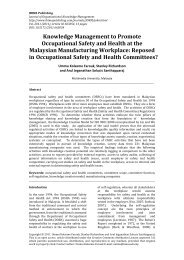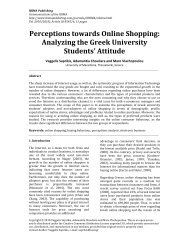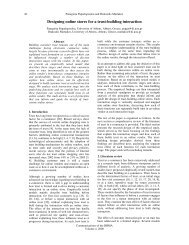Full Text PDF - IBIMA Publishing
Full Text PDF - IBIMA Publishing
Full Text PDF - IBIMA Publishing
You also want an ePaper? Increase the reach of your titles
YUMPU automatically turns print PDFs into web optimized ePapers that Google loves.
138<br />
Information Technology Governance in the Malaysian Electronics Manufacturing Industry<br />
Information Technology Governance in the Malaysian Electronics<br />
Manufacturing Industry<br />
Khong Sin Tan, Multimedia University, Melaka, Malaysia, kstan@mmu.edu.my<br />
Uchenna Cyril Eze, Multimedia University, Melaka, Malaysia, uchenna.eze@mmu.edu.my<br />
Wil Ly Teo, Multimedia University, Melaka, Malaysia, wlteo@yahoo.com<br />
Abstract:<br />
Research indicates that information technology (IT)<br />
governance is attracting enormous attention from<br />
practitioners and academics. This is fueled by the<br />
growing importance of IT governance in the delivery<br />
of IT compliance and in its ability to create value for<br />
businesses. IT compliance minimizes risk while IT<br />
governance manages risks. This paper is a<br />
preliminary report on an electronic survey of 33 firms<br />
operating in Malaysian electronics industry. Three<br />
key frameworks underpinned the conceptual<br />
development in this paper. The findings indicate that<br />
IT governance is important to profit- and growthoriented<br />
organisations in terms of cost efficiency,<br />
growth, asset utilisation and business flexibility.<br />
Organisations realise the benefits of IT governance<br />
but unfamiliar with the IT frameworks. Additional<br />
implications of these findings to the electronics<br />
manufacturing industry and policy makers in<br />
Malaysia are presented.<br />
Background of Study<br />
Information technology [IT] governance is relatively<br />
new in Malaysia. In fact, there are limited studies<br />
about IT governance in Malaysia. While<br />
organisations are getting bigger in terms of annual<br />
revenue or number of employees, the IT<br />
infrastructure in organisations becomes more<br />
complex. In this regard, proper management of IT is<br />
imperative to ensure that IT risks are mitigated and<br />
also that IT brings positive values to organisations.<br />
The electrical and electronics industry is Malaysia's<br />
leading industrial sector, contributing significantly to<br />
the country's manufacturing output, exports and<br />
employment. In 2006, gross output of the industry<br />
totalled RM214.9 billion (US$63.2 billion), while the<br />
industry's exports of electrical and electronics<br />
products amounted to RM282.2 billion (US$83<br />
billion) or 61.7% of total manufactured exports. The<br />
industry created 397,553 jobs opportunities,<br />
accounting for 36.6% of total employment in the<br />
manufacturing sector (www.mida.gov.my). This<br />
research, therefore, is an effort to determine the<br />
perceptions of organizations’ IT governance practice<br />
in this industry. Thus, this research is tries to answer<br />
the research question: How aware are these firms<br />
about the impact of IT governance on Malaysian<br />
electronics manufacturing industry?<br />
The following section reviews the literature relevant<br />
to the research topic. The methodology used is<br />
detailed before the results are presented. Finally, the<br />
findings are discussed and implications of the results<br />
are presented before the paper is concluded.<br />
Literature Review<br />
The popularity of information technology (IT) usage<br />
among companies has called for a specific focus on<br />
IT governance [3]. IT governance is important<br />
because it ensures sustainable system operations and<br />
reduces the organisation’s vulnerability to crises<br />
resulting from system failures. IT is often the weakest<br />
link in an organisation’s overall governance structure<br />
[1][8] and therefore deserves greater attention.<br />
IT governance and IT compliance are two different<br />
concepts. Kennan [4] described IT compliance as a<br />
cost which, does not deliver any benefit to the<br />
business. On the other hand, IT governance delivers<br />
compliance and creates value for the business.<br />
Moreover, the objective of compliance is to minimise<br />
risk, whereas governance is to manage risk.<br />
Therefore, IT governance is more than mere<br />
compliance with regulatory requirements.<br />
IT governance is about optimum returns from<br />
investment in IT and how to ensure that measurable<br />
and transparent long-term, sustainable stakeholder<br />
value is achieved [11]. Hence extracting maximum<br />
value from existing investment is imperative for IT<br />
governance [6]. IT Governance Institute [3] defines<br />
IT governance as the leadership and organisational<br />
structures and processes that ensure the<br />
organisation’s IT sustains and extends the<br />
organisation’s strategies and objectives. Weill and<br />
Ross [10] offered a simpler yet encompassing<br />
definition of IT governance as specifying the decision<br />
rights and accountability framework to encourage<br />
desirable behaviour in the use of IT.<br />
Common Coordination of Decision-Making<br />
Mechanisms<br />
There are various common coordination of decisionmaking<br />
mechanisms, including:<br />
Communications of the <strong>IBIMA</strong><br />
Volume 3, 2008
Khong Sin Tan, Uchenna Cyril Eze and Wil Ly Teo<br />
139<br />
• A steering committee which comprises of either<br />
representatives from business, IT or a mixture of<br />
both.<br />
• An IT relationship or account manager dedicated<br />
to specific business units or functions.<br />
• An architecture committee to ensure business<br />
and technical standardisation and integration.<br />
• A budgeting, investment or project decision<br />
committee to reconcile conflicting business<br />
needs requiring limited IT resources.<br />
Monitoring Execution<br />
Once decisions are made, monitoring and periodic<br />
reviews are necessary to ensure the execution is on<br />
the right path. The mechanisms for monitoring<br />
execution include:<br />
• Architecture review or exception process<br />
• Standard operation management processes for IT<br />
service support and delivery<br />
• Service level agreements<br />
• Organisation-wide project management<br />
methodology<br />
• Cost forecasting and controlling processes<br />
• Key performance indicators or balanced<br />
scorecard<br />
Communication with Stakeholders<br />
Communication encompasses announcements,<br />
advocates, channels, and education efforts that<br />
disseminate IT governance principles and policies<br />
and outcomes of IT decision-making processes [10].<br />
These include:<br />
• Communication sessions by senior business and<br />
IT management<br />
• Electronic communication (e.g. announcements,<br />
newsletters, intranets)<br />
• Personal involvement of senior IT management<br />
to ensure buy-in and compliance by renegades<br />
(managers who do not follow the rules, either<br />
due to ignorance or disagreement)<br />
Industry Frameworks Related to IT Governance<br />
There are three frameworks related to IT governance.<br />
The three frameworks are Control Objectives for<br />
Information and related Technology (CobiT), IT<br />
Infrastructure Library (ITIL) and Capability Maturity<br />
Model Integration (CMMI).<br />
CobiT was developed in the early 1990s by<br />
Information Systems Audit and Control Association<br />
(ISACA) with the goal of providing a set of best<br />
practices that are meaningful and useful to IT staff,<br />
auditors, and customers. CobiT is organised into four<br />
domains: planning and organisation, acquisition and<br />
implementation, deployment and support, and<br />
monitoring with a total of 34 high-level control<br />
objectives. Each of the high-level control objectives<br />
is divided into detailed control objectives. CobiT<br />
identifies a broad set of 318 control points designed<br />
to provide reasonable assurance that certain<br />
objectives will be achieved [3].<br />
ITIL was developed in the late 1980s by the UK’s<br />
Office of Government Commerce (OGC) [5]. The<br />
OGC started the project in recognition of the fact that<br />
government organisations were becoming<br />
increasingly dependent on Information Technology.<br />
The objectives of the OGC in developing ITIL were<br />
to promote IT business effectiveness and to reduce<br />
costs while maintaining or improving IT services.<br />
The library includes scope of implementing ITIL<br />
processes through applying life cycle management<br />
and the core of ITIL IT operations processes. It has<br />
become the global benchmark by which organisations<br />
measure the quality of IT service management [5].<br />
CMMI for software development was established in<br />
1986 at Carnegie Mellon University by the Software<br />
Engineering Institute (SEI) [7]. It was originally<br />
developed for the U.S. Defence Department to<br />
manage large and complex development projects, but<br />
has gradually gained recognition in both the public<br />
and private sectors as a useful framework for<br />
improving software development processes and<br />
application quality. CMMI defines five stages of<br />
organisational maturity with respect to software<br />
development. Predictability, effectiveness, and<br />
control of an organisation's software processes are<br />
believed to improve as the organisation moves up<br />
these five levels [7].<br />
Research Methodology<br />
Questionnaire<br />
This study is carried out using a set of questionnaire.<br />
Items in questionnaire are prepared based on<br />
literature as described in Section 2. Respondents can<br />
choose to complete the survey either online or<br />
through e-mail. Demographic items are evaluated<br />
using dichotomous scaling. All other variables are<br />
interval-scaled. There are three categories;<br />
coordination, monitoring and communication<br />
mechanisms (Section 2.1), monitor execution of IT<br />
decisions (Section 2.2), and communicate IT issues<br />
(Section 2.3). We measure the questions in these<br />
categories using 5-point Likert scale, ranging from<br />
1=Never, 2=Rarely, 3=Sometimes, 4=Often and<br />
5=Always. The IT governance frameworks (Section<br />
2.4) are rated by 1=Currently Used, 2=Intend to Use,<br />
3=No Intention to Use, and 4=Never Heard of.<br />
Communications of the <strong>IBIMA</strong><br />
Volume 3, 2008
140<br />
Information Technology Governance in the Malaysian Electronics Manufacturing Industry<br />
IT governance performance are categorised into two<br />
parts. One part is about the importance of IT<br />
governance outcomes which is scaled as 1=Totally<br />
Not Important, 2=Not Important, 3=Quite Important,<br />
4=Important and 5=Very Important. The second part<br />
concerns the influence of IT governance in business.<br />
The scales we used are 1=Totally Not Successful,<br />
2=Not Successful, 3=Quite Successful, 4=Successful<br />
and 5=Very Successful.<br />
Selection of Study Area and Sampling<br />
We used simple random sampling method to select<br />
participants in this study. Respondents are randomly<br />
selected from the member directory of the Federation<br />
of Malaysian Manufacturers, which contains around<br />
1000 members, as well as through industry contacts.<br />
The organisations included in this research are<br />
involved in the manufacture of one or more of the<br />
following products: diode, electronic, integrated<br />
circuit, memory product, resistor, semiconductor,<br />
sipmos, transistor, and wafer.<br />
Care was taken in selecting participants from the<br />
population frame by removing obvious mismatches<br />
(e.g. “wafer” as a product of the food industry, as<br />
opposed to “wafer” fabrication in the semiconductor<br />
industry). The finalised population frame consists of<br />
33 organisations. All selected organisations in the list<br />
are invited to participate in the survey which ran for<br />
approximately one month.<br />
Analyses and Results<br />
Out of 84 e-mails sent to respondents, 33 respondents<br />
answered the questionnaires online, while 2 declined<br />
to participate citing confidentiality as a reason.<br />
Therefore, 33 usable survey responses (N=33) were<br />
collected which represented 39.3% response rate.<br />
Table 1 indicates the distribution of annual revenue.<br />
The table shows that the figures are skewed towards<br />
large corporations with over RM 50 million of annual<br />
revenue. Over half of the respondents (63.6 per cent)<br />
are from organisations with over RM100 million of<br />
annual revenue.<br />
Table 1: Annual revenue of company (N=33)<br />
Table 2 shows the distribution of strength of<br />
workforce in organisations. Many respondents (63.6<br />
per cent) have more than 1000 employees. From the<br />
amount of annual revenue and size of workforce, it<br />
can be concluded that organisations that participated<br />
in this study are considerably big.<br />
Table 2: Strength of workforce in company (N=33)<br />
Items Freq. % Valid<br />
%<br />
Cum.<br />
%<br />
> 100 up to 1000 12 36.4 36.4 36.4<br />
> 1000 21 63.6 63.6 100.0<br />
Total 33 100.0 100.0<br />
In the quest for a new customer base and product<br />
innovation, growth-oriented organisations require<br />
extremely agile IT systems and flexible IT services to<br />
deal with fast-changing business requirements. On<br />
the other hand, organisations with profit as the<br />
primary goal strive to maximise profit through<br />
operational efficiencies and economies of scale by<br />
standardised and tightly controlled processes and<br />
tools. Table 3 indicates that the numbers of<br />
respondents with profit or growth oriented are almost<br />
equal in this study. There are 18 organisations (54.5<br />
per cent) which emphasise profit as organisation goal<br />
while 15 organisations (45.5 per cent) see growthoriented<br />
as their focus in business.<br />
Table 3: Primary goal of company (N=33)<br />
Items Freq. % Valid<br />
%<br />
Cum.<br />
%<br />
Profit 18 54.5 54.5 54.5<br />
Growth 15 45.5 45.5 100.0<br />
Total 33 100.0 100.0<br />
Table 4 shows that budgeting or investment<br />
committee and project decision committee often or<br />
always participate in making decision on IT activities.<br />
Architecture and steering committee sometimes get<br />
involved in IT decision making while IT relationship<br />
managers is the least to get involved.<br />
Items Freq. % Valid<br />
%<br />
Cum.<br />
%<br />
> RM 1-10 mil 3 9.1 9.1 9.1<br />
> RM 10-50 mil 3 9.1 9.1 18.2<br />
> RM 50-100 mil 6 18.2 18.2 36.4<br />
> RM 100 mil 21 63.6 63.6 100.0<br />
Total 33 100.0 100.0<br />
Communications of the <strong>IBIMA</strong><br />
Volume 3, 2008
Khong Sin Tan, Uchenna Cyril Eze and Wil Ly Teo<br />
141<br />
Table 4: Coordinate IT decision-making activities<br />
(N=33)<br />
Items Mean Std.<br />
Dev.<br />
Steering committee which 3.45 .617<br />
comprises of either<br />
representatives from<br />
business, IT or a mixture of<br />
both<br />
IT relationship/account 3.09 .843<br />
manager dedicated to<br />
specific business units or<br />
functions<br />
Architecture committee 3.48 .834<br />
Budgeting or investment 3.61 .827<br />
committee<br />
Project decision committee 3.70 .728<br />
Table 5 indicates that there are four matters that are<br />
often monitored during IT decision executions. Cost<br />
forecasting and controlling process (Mean=3.82), key<br />
performance indicators (Mean=3.73), service level<br />
agreements (Mean=3.70) and standard operation<br />
management process (Mean=3.64) are the IT<br />
decisions that are often being monitored. These four<br />
criteria are main focus of IT monitoring during<br />
decision makings.<br />
Table 5: Monitor execution of IT decisions (N=33)<br />
Items Mean Std.<br />
Dev.<br />
Architecture review 3.42 .751<br />
process<br />
Standard operation 3.64 .699<br />
management process<br />
Service level<br />
3.70 .918<br />
agreements<br />
Project management 3.39 .827<br />
methodology<br />
Cost forecasting and 3.82 .950<br />
controlling process<br />
Key performance<br />
indicators or balanced<br />
scorecard<br />
3.73 .876<br />
Table 6 indicates IT issues are often communicated<br />
through electronic communication. This is the most<br />
frequently used communication medium compared to<br />
the other two. Electronic communication is<br />
considered to be the best medium to bring IT issues<br />
and decisions to busy senior business and IT<br />
management and managers.<br />
Table 6: Communicate IT issues (N=33)<br />
Items Mean Std.<br />
Dev.<br />
Communication sessions by 3.82 .846<br />
senior business and IT<br />
management<br />
Electronic communication 4.64 .489<br />
(e.g. announcements,<br />
newsletters, intranets)<br />
Personal involvement of<br />
senior IT management to<br />
ensure buy-in and<br />
compliance by managers<br />
who do not follow the rules,<br />
either due to ignorance or<br />
disagreement<br />
3.91 .678<br />
Table 7 indicates that many respondents either have<br />
no intention to use or have never heard of the three IT<br />
governance frameworks. However, based on the<br />
findings, the three frameworks are equally important<br />
because the numbers of current users for the three IT<br />
governance frameworks are almost equal. There are<br />
5 current users for CobiT, 4 current users for ITIL<br />
and 5 current users for CMMI. There are almost<br />
equal numbers of users as well who intend to use the<br />
different frameworks in future. However, it is<br />
surprising that many respondents are not aware of<br />
these frameworks<br />
Communications of the <strong>IBIMA</strong><br />
Volume 3, 2008
142<br />
Information Technology Governance in the Malaysian Electronics Manufacturing Industry<br />
Table 7: Awareness and usage frequency of various industry frameworks related IT<br />
Governance framework (N=33)<br />
Items Mean Std.<br />
Dev.<br />
Currently<br />
Used (N)<br />
Intend to<br />
Use (N)<br />
No Intention<br />
to Use (N)<br />
Never Heard<br />
of (N)<br />
CobiT 2.88 1.083 5 6 10 12<br />
ITIL 2.73 0.911 4 7 16 6<br />
CMMI 2.73 1.069 5 9 9 10<br />
IT governance performance is measured by two<br />
methods. One method measures respondents’<br />
expectation for implementing IT governance.<br />
The Mean values in Table 8 indicate that all<br />
respondents feel that IT governance is very<br />
important in bringing positive values to cost,<br />
growth, asset utilisation and business flexibility<br />
to business. Table 9 shows the breakdown of<br />
their response on each item.<br />
Table 8: Importance of IT governance Outcomes (N=33)<br />
Items Mean Std. Dev.<br />
Cost 4.55 .506<br />
Growth 4.27 .452<br />
Asset utilisation 4.18 .584<br />
Business flexibility 4.27 .452<br />
Table 9: Breakdown of importance of IT governance outcomes<br />
Items<br />
Very<br />
Important<br />
Important Quite<br />
Important<br />
Not<br />
Important<br />
Totally Not<br />
Important<br />
Cost 18 15 0 0 0<br />
Growth 9 24 0 0 0<br />
Asset Utilisation 9 21 3 0 0<br />
Business Flexibility 9 24 0 0 0<br />
Table 10 shows the influence of IT governance<br />
on the same 4 items as depicted in Table 8.<br />
Again, respondents view the influence of IT<br />
governance in business with respect to the 4<br />
items is successful. Table 11 shows the<br />
breakdown of their response on each item.<br />
Table 10: Influence of IT governance (N=33)<br />
Items Mean Std. Dev.<br />
Cost 3.55 .666<br />
Growth 3.27 .452<br />
Asset utilization 3.27 .626<br />
Business flexibility 3.55 .666<br />
Table 11: Breakdown of Influence of IT Governance<br />
Items<br />
Very<br />
Successful<br />
Successful Quite<br />
Successful<br />
Not<br />
Successful<br />
Totally Not<br />
Successful<br />
Cost 3 12 18 0 0<br />
Growth 0 9 24 0 0<br />
Asset Utilization 3 3 27 0 0<br />
Business Flexibility 3 12 18 0 0<br />
Communications of the <strong>IBIMA</strong><br />
Volume 3, 2008
Khong Sin Tan, Uchenna Cyril Eze and Wil Ly Teo<br />
143<br />
Discussions and Implications<br />
The monitoring of IT decisions is important<br />
especially during the IT investment forecast<br />
process. IT investment as initial process of IT<br />
project rollout may need more thoughts to ensure<br />
smooth planning and controlling in the ensuing<br />
phase. Thus, this study indicates that two<br />
committees; project decision committee and<br />
budgeting or investment committee play<br />
important roles in IT decision making activities.<br />
Organisations prefer using electronic<br />
communication to discuss IT issues. This result<br />
is not surprising because of the popularity of<br />
information technology like the Internet. In<br />
order to make sure that IT issues are<br />
disseminated to everyone, senior business and IT<br />
management as well as managers must be in the<br />
communication loop.<br />
This study indicates organisations have no<br />
intention or never heard of IT governance. This<br />
may be because organisations commonly have IT<br />
department, which oversee the IT systems and<br />
operations in organisations. The IT department<br />
manages, avoids and contains IT risks but not to<br />
the extent of bringing IT values to organisations.<br />
However, although the many organizations are<br />
somewhat unfamiliar to the three frameworks, IT<br />
governance is found to be very important in<br />
bringing expected outcomes in terms of cost,<br />
growth, asset utilisation and business flexibility<br />
particularly in IT area. Moreover, proper IT<br />
governance according to most respondents will<br />
help organisations succeed in cost cutting, faster<br />
growth, more efficient use of assets and to be<br />
more fragile and flexible in the industry.<br />
Conclusions and Suggestions for Future<br />
Research<br />
This exploratory study is beneficial to academic<br />
researchers and industry players who are<br />
interested in understanding the as-is situation of<br />
IT governance level in electronics manufacturing<br />
industry in Malaysia. There is limited prior<br />
academic research on IT governance in Malaysia,<br />
and in particular within this industry. More<br />
researches are expected in future to bring more<br />
in-depth insights into the practice of IT<br />
governance in industries in Malaysia. Moreover,<br />
future researches can perform inferential<br />
analyses to explore more concrete findings.<br />
From the perspective of the bigger picture of<br />
regulatory requirements on corporate governance,<br />
this research serves as a starting point for IT<br />
organisations embarking on this journey. Today,<br />
IT governance is already recognised as an<br />
integral part of corporate governance. Therefore,<br />
organisations and policy makers should devise<br />
plans to implement and govern IT in business.<br />
This is to avoid any potential pitfalls and taking<br />
earlier remedial measures. For example, the<br />
string of corporate scandals starting with Enron<br />
led to the subsequent passage of the Sarbanes-<br />
Oxley Act in the United States in 2002.<br />
Organisations were forced to re-examine their<br />
overall corporate governance structures and the<br />
underlying individual governance frameworks to<br />
ensure proper fiscal accountability to<br />
shareholders and stakeholders [9].<br />
This study also serves to remind top<br />
management, particularly CEOs and CIOs in<br />
Malaysia to give higher commitment towards IT<br />
governance in their organisation. Alignment<br />
between business and IT objectives will position<br />
IT for strategic partnership towards achieving<br />
business goals. This is in line with the two<br />
fundamental concerns of IT governance stated in<br />
the beginning: IT’s delivery of value to the<br />
business and mitigation of IT risks.<br />
References:<br />
[1] Huber, N. “IT looks the weak link in<br />
compliance,” Computer Weekly, 27 July 2004, p.<br />
4.<br />
[2] IT Governance Institute. “Board briefing on<br />
IT governance (2nd ed.),” Illinois, IL: Author,<br />
2003.<br />
[3] IT Governance Institute. “COBIT 4.0”,<br />
Illinois, IL: Author, 2005.<br />
[4] Kennan, P. “IT failures are a boardroom<br />
issue,” Computer Weekly, 6 Sepember 2003, p.<br />
40.<br />
[5] Office of Government Commerce. “The IT<br />
Infrastructure Library,” Norwich: Author,2000.<br />
[6] Parker, B. “Study reveals extracting value is<br />
top IT governance imperative”, Manufacturing<br />
Business Technology, (23:10), October, 2005, p.<br />
44.<br />
[7] Software Engineering Institute. “Capability<br />
Maturity Model Integration (CMMI) Overview,”<br />
Pittsburgh, PA: Carnegie Mellon University,<br />
2005.<br />
Communications of the <strong>IBIMA</strong><br />
Volume 3, 2008
144<br />
Information Technology Governance in the Malaysian Electronics Manufacturing Industry<br />
[8] Trites, G. “Director Responsibility for IT<br />
Governance,” International Journal of<br />
Accounting Information Systems, (5:2), 2004, pp.<br />
89-100.<br />
[9] Vlahakis, P. A., Wintner, J. M., and<br />
Cammaker, J. R. “Understanding the Sarbanes-<br />
Oxley Act of 2002,” Corporate Governance<br />
Advisor, (10:5), 2002, pp. 13-17.<br />
[10] Weill, P., and Ross, J. W. (2004). “IT<br />
governance: How Top Performers Manage IT<br />
Decision Rights for Superior Results”,<br />
Watertown, MA: Harvard Business School Press,<br />
2004.<br />
[11] Williams, P. “Wanted! Meeting of minds at<br />
the top”, Computer Weekly, 13 June 2006, pp.<br />
30-32.<br />
Copyright © 2008 by the International Business<br />
Information Management Association (<strong>IBIMA</strong>). All<br />
rights reserved. Authors retain copyright for their<br />
manuscripts and provide this journal with a<br />
publication permission agreement as a part of <strong>IBIMA</strong><br />
copyright agreement. <strong>IBIMA</strong> may not necessarily<br />
agree with the content of the manuscript. The content<br />
and proofreading of this manuscript as well as and any<br />
errors are the sole responsibility of its author(s). No<br />
part or all of this work should be copied or reproduced<br />
in digital, hard, or any other format for commercial<br />
use without written permission. To purchase reprints<br />
of this article please e-mail: admin@ibima.org.<br />
Communications of the <strong>IBIMA</strong><br />
Volume 3, 2008


